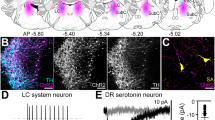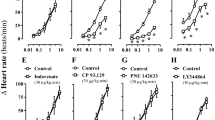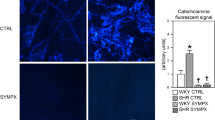Abstract
RESERPINE treatment causes an increase in the activity of tyrosine hydroxylase (T-OH) in the superior cervical ganglion of the rat. A single systemic injection of the drug produces a rise in enzyme activity that reaches a maximum 48–72 h later1. No change in T-OH is seen if the preganglionic cholinergic tract is cut at the time of reserpine administration or if animals are pretreated with the ganglion blocking agents pempidine or chlorisondamine2,3. In the cat, direct electrical recording from the preganglionic cervical sympathetic trunk has revealed increased neuronal firing after reserpine administration4. These findings suggest that the rise in T-OH activity elicited by reserpine is mediated trans-synaptically through an increase in ganglionic transmission.
This is a preview of subscription content, access via your institution
Access options
Subscribe to this journal
Receive 51 print issues and online access
$199.00 per year
only $3.90 per issue
Buy this article
- Purchase on Springer Link
- Instant access to full article PDF
Prices may be subject to local taxes which are calculated during checkout
Similar content being viewed by others
References
Mueller, R. A., Thoenen, H., and Axelrod, J., J. Pharmac. exp. Ther., 169, 74 (1969).
Thoenen, H., Mueller, R. A., and Axelrod, J., Nature, 221, 1264 (1969).
Mueller, R. A., Thoenen, H., and Axelrod, J., Eur. J. Pharmac., 10, 51 (1970).
Iggo, A., and Vogt, M., J. Physiol., Lond., 150, 114 (1960).
Hendry, I. A., and Iversen, L. L., Brain Res., 29, 159 (1971).
Lowry, O. H., Roseborough, N. J., Farr, A. L., and Randall, R. J., J. biol. Chem., 193, 265 (1951).
Grollman, A. P., and Huang, M. T., Fedn. Proc., 32, 1673 (1973).
Mueller, R. A., Thoenen, H., and Axelrod, J., Molec. Pharmac., 5, 463 (1969).
Otten, U., Paravicini, U., Oesch, F., and Thoenen, H., Experienta, 29, 765 (1973).
Patrick, R. L., and Kirshner, N., Molec. Pharmac., 7, 87 (1971).
Author information
Authors and Affiliations
Rights and permissions
About this article
Cite this article
ZIGMOND, R., MACKAY, A. Dissociation of Stimulatory and Synthetic Phases in the Induction of Tyrosine Hydroxylase. Nature 247, 112–113 (1974). https://doi.org/10.1038/247112a0
Received:
Issue Date:
DOI: https://doi.org/10.1038/247112a0
Comments
By submitting a comment you agree to abide by our Terms and Community Guidelines. If you find something abusive or that does not comply with our terms or guidelines please flag it as inappropriate.



